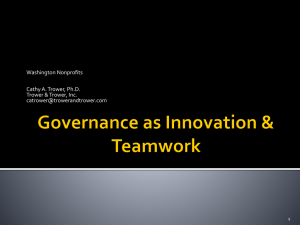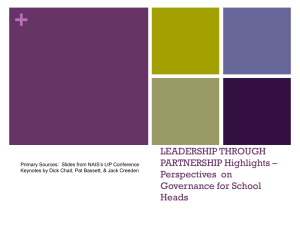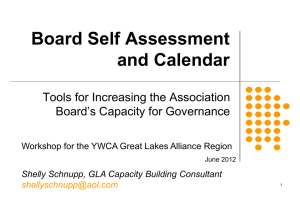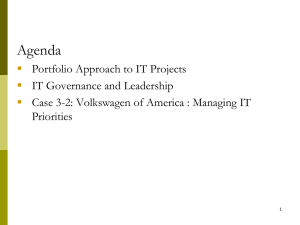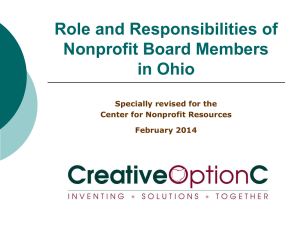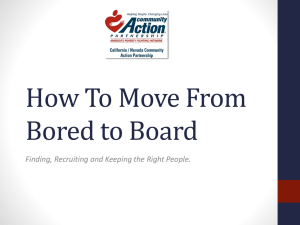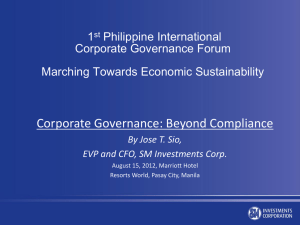"A good board is a victory, not a gift." Cyril O
advertisement
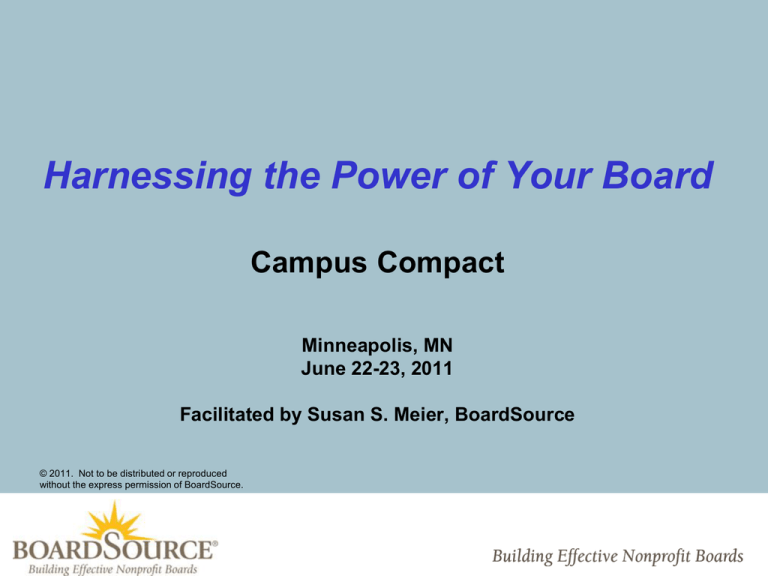
Harnessing the Power of Your Board Campus Compact Minneapolis, MN June 22-23, 2011 Facilitated by Susan S. Meier, BoardSource © 2011. Not to be distributed or reproduced without the express permission of BoardSource. BoardSource • Advances the public good by building exceptional nonprofit boards and inspiring board service • Supports and promotes excellence in nonprofit board service • Is the premier source of cutting-edge thinking and resources related to boards • Engages and develops the next generation of board leaders Susan Meier • Vice President, Consulting & Training at BoardSource • Former Vice President of Chapter Services for national federated nonprofit • Corporate experience • National and local board member and officer experience Learning Objectives • • • • To gain a clearer understanding of key nonprofit board roles & responsibilities To learn more about governance promising practices To learn how to reframe the work of the board in the fiduciary, strategic and generative modes To understand the core components in building a Constructive Partnership between the board and chief executive Agenda – June 22 • Introductions • Silent Start • Three Roles of Nonprofit Boards – 10 Basic Board Responsibilities • Lunch • Case Study • Individual Board Member Responsibilities • Effective Board Meetings • Closing Thoughts for the Day Introductions • Name/state • How long have you served as State Director? • Affiliate Stats – Status (501©(3), etc) – Budget – Primary program – Board size & composition – Frequency of board meetings • Mode of transportation that best describes board • One thing you want from this training Guidelines for Today Please turn off cell phones, pagers & PDA’s… Please return from breaks & lunch on time… Your participation is vital to our collective success… Practice “Active Listening”… Be present in the moment… Setting the Context • • • • • • • • Increasing community needs Increased scrutiny Increased regulation Changing demographics Generational issues Decreasing resources Blurring of the sectors Advances in technology What is Governance? To govern is to steer, to control, and to influence from a position of authority. Silent Start Our Goal – More Effective Boards Exceptional Responsible Functional Dysfunctional Unconscious Conscious Enlightened A General Direction… Good Great Success Significance Stewardship Exceptional Leadership Board Roles and Responsibilities Exercise • In small groups, identify and list the 10 primary responsibilities of a nonprofit board. Primary Board Responsibilities 1. Set Organizational Direction • Determine mission and purpose • Ensure effective planning 2. Ensure the Necessary Resources • Ensure adequate financial resources • Select the chief executive • Build a competent board • Enhance the organization’s public standing 3. Provide Oversight • Monitor and strengthen programs and services • Protect assets and provide financial oversight • Ensure legal and ethical integrity • Support and evaluate the chief executive 3 Overarching Board Roles 1. Set organizational direction 2. Ensure necessary resources 3. Provide oversight Board Role 1: Set Organizational Direction • Developing and maintaining a focus on mission, e.g: – What is our mission? Our vision? – What are our values? – What issues must we confront in order to carry out our mission? – Where should we be in five years? • Visioning and strategic planning • Understanding board’s role in fulfilling the plan Definitions • Mission: why we exist • Vision: what the world would look like if we achieved our mission (aspirational) • Values: the principles that guide us in our work Strategic Planning • Strategic planning vs operational planning • Environmental scan • Mission, vision, values • Strategies, goals, tasks, timeline, responsible parties • Develop a thoughtful process • Scenario planning Tips • Revisit your mission periodically. Is it still relevant? Easy to remember? Taps into your passion? • The strategic planning process is as important as the outcomes. • When making decisions, ask: Is this in alignment with our mission & values? • Focus on that which is most important. Board Role 2: Ensure Resources • Identify resources needed: 1. 2. 3. 4. • Funds Leadership (executive and board) Reputation Facilities/Technology Establish policies for how these resources will be acquired 1. 2. Financial resources Public relations • Determine how board members will participate in resource development 1. Fundraising 2. Board member recruitment 3. Spreading the word Adequate Financial Resources • The full board can participate in various ways, e.g.: – Board members contribute financially – Board members help develop a fundraising plan – Board members support the chief executive’s solicitation efforts – Board members actually solicit • It is always the board’s responsibility to ensure adequate resources for the organization to remain financially viable Break! Capable Staff Leadership • Selection of State Director, e.g.: – Single most important decision of any board – Succession planning • Support of State Director, e.g.: – Set expectations clearly – Provide training – Assist State Director when Board members overstep/misunderstand roles • Evaluating State Director, e.g.,: – Frequent and constructive feedback Board Diversity The Board Building Cycle Identify Rotate Evaluate Cultivate Celebrate! Recruit Orient Educate Involve Formal Board Orientation To the organization: • Mission & History • Programs • Finances & key funding sources • Structure (organization chart) To the culture: • What kind of culture do we have? • What are our organizational values? • How are decisions made? • How do our board members communicate with one another? To the board: • List of board members & officers • Committee structure • Bylaws • Key policies (eg, conflict of interest) • Board meeting dates • Key strategic issues To governance: • How does this board manage itself? • Role of board vs staff • Board member responsibilities • Importance of fiduciary &strategic work • Federal and state filings Orientation Tips and Tools Tips Tools • Be honest, but don’t • Orientation meeting overwhelm • Board handbook • Include staff & board • Site visit/facilities tour members • Make room for team building • Follow up with individuals • Use a “buddy” system Board Committee Structure • • • • • • • Keep it simple and flexible Be strategic Fewer, not more, committees Ensure clear committee charters Create an Audit Committee, if needed Use Executive Committees thoughtfully Create a Governance Committee Governance Committee – Promotes and provides education about the organization, field, and governance – Assesses the organization’s governance needs – Identifies, nominates, and orients new members – Develops leadership/nominates officers – Conducts board self assessment – Organizes the annual board retreat Positive Public Image • Board members serve as ambassadors • An accurate image and positive reputation will influence organizational resources • Success of most organizations depends on external relations • Board needs to ensure that stakeholders are kept informed Tips • Recruit a strategically composed board to the degree you can. • Ensure diverse funding streams. • Ensure the right leadership is in place at the right time. • Discuss & develop board member job description. • Develop a strategic committee structure. • Use task forces to help minimize the number of standing committees. Board Role 3: Provide Oversight • Program -- plan, monitor and evaluate impact • Financial -- establish budget guidelines, oversee financial management, secure auditor • Risk management • Evaluation of State Director • Legal and moral oversight -- manage compliance, values, conflicts of interest, and accountability Graphic Dashboard Source: Lawrence M. Butler author of The Nonprofit Dashboard: A Tool for Tracking Progress (BoardSource, 2007). Questions 1. How might your board seek to evaluate the quality of your organization’s programs? 2. How can your board ensure that all board members have a clear picture of your organization’s financial health? 3. Is your board evaluating you and the board itself? Is Your Board Asleep at the Wheel? 1. What are areas of potential risk and liability for boards of directors/trustee? 2. What is SOX and does it apply to nonprofits? 3. What are the three duties of board members? 4. Does everyone know how much the chief executive makes? 5. What governing bodies have authority or power over tax-exempt organizations? Definitions BusinessDictionary.com •Risk Management – Policies, procedures and practices involved in identification, analysis, assessment, control and avoidance, minimization or elimination of unacceptable risks. •Risk (General): Probability or threat of a damage, injury, liability, loss, or other negative occurrence, caused by external or internal vulnerabilities, and which may be neutralized through pre-mediated action. How Does Your Board Manage Risks? 1. Informed board members 2. Written records and policies 3. Adequate insurance 4. Audits 5. Supervision 6. Conflict of interest enforcement 7. Whistle blower protection 8. Timely filings 9. Oversight & protection of assets 10. Due diligence Legal and Moral Oversight • Ensure compliance with legal requirements • Act in accordance with bylaws and review them every 3 years (or as needed) • Adopt appropriate policies (document retention & destruction; whistleblower; conflict of interest) • Articulate and safeguard organizational values • Avoid or, if necessary, manage conflicts of interest • Ensure accountability by all parties Tips • Adopt a conflict of interest policy. – Have all board members and executive staff sign the conflict of interest policy annually, disclosing conflicts. – Ensure that board members recuse themselves from board discussions and votes appropriately. • Develop a dashboard to facilitate oversight. • Ensure the board meets in executive session with the auditor. • Formally evaluate the chief executive annually. • Conduct a board self assessment every 2-3 years. Lunch! Exercise Roles and Responsibilities Small Group Deliberations Discuss one board responsibility that is a priority for your board to address. •Identify challenges •Identify 2-3 tools/strategies to overcome each challenge Individual Board Member Roles and Responsibilities Board Member Responsibilities • Actively Participate – – – – Provide time, talent, and treasure Attend all meetings and specified events Serve on committees, carry out assignments Help raise money • Be Informed – About mission, programs – Prepare for meetings – Stay current with related issues and organizations • Be Independent-Minded Board Member Responsibilities (cont’d) • Ask Good Questions • Promote the Organization – Spread the word – Recruit board members and other volunteers • Safeguard Legal Standards, Ethics and Values – Follow conflict-of-interest and confidentiality policies – Refrain from asking special favors from staff – Fulfill legal obligations Governing Board Member’s Legal Obligations • Duty of Care – Using your best judgment – Actively participating, paying attention – Asking pertinent questions • Duty of Loyalty – Avoiding conflicts of interest – Putting aside personal and professional interests • Duty of Obedience – Staying true to the organization’s mission – Obeying the law, both public and organizational Duty of Care • A board member must exercise the same care that an ordinary, prudent person would exercise in a like position or under similar circumstances. – Using your best judgment – Actively participating, paying attention – Asking pertinent questions – Attend board meetings (no proxy) Duty of Loyalty • Act in good faith, be faithful to the organization, and pursue its best interests (e.g., put the interests of the organization above selfinterest). – Avoiding conflicts of interest – Putting aside personal and professional interests – Respecting confidentiality Conflict of Interest: Definition A conflict of interest arises whenever the financial or personal interests of a board member, officer or management employee are, or appear to be, in conflict or at odds with the interests of the organization, such that he or she may be influenced by this personal interest when making a decision for the organization. How to Deal with Conflicts of Interest • Be thoughtful and intentional • Develop a sound policy that clearly articulates: • Who does the policy apply to? • What is the definition of a conflict of interest? • What is the process for disclosure, review, recusal and voting? • How will the action be recorded? • Is the policy signed annually by board members and key staff? • Create a culture in the boardroom where real and perceived conflicts are actively discussed Duty of Obedience • Act in accordance with the organization’s rules and policies, and in furtherance of its goals as stated in the mission statement, articles of incorporation and bylaws • Comply with state and federal laws • Not act outside the scope of corporate powers – Staying true to the organization’s mission – Obeying the law, both public and organizational Enhanced Board Engagement via Effective Meetings Optimize your limited time together by designing board meetings to be productive, engaging and focused on substantive issues. Thoughtfully Crafted Agenda Careful Framing of Questions Built-In Educational Time Consent Agenda Dashboards Annual Calendar of Meetings Board Retreats Focused Pre-Readings/Board Books Expert Guests/Facilitators Executive Sessions Points to Ponder • Do we have the right leaders in place to lead us into tomorrow? • Do we understand our roles and responsibilities as a board? • Do we have a governance structure in place that allows our board to function effectively? • What is the greatest contribution our board can potentially make to the organization? Closing Thoughts on the Day Harnessing the Power of Your Board Campus Compact Minneapolis, MN June 23, 2011 Facilitated by Susan S. Meier, BoardSource © 2011. Not to be distributed or reproduced without the express permission of BoardSource. Agenda – June 23 • Snapshot of Wednesday’s Work • Constructive Partnership • Reframing the Work of the Board – The Fiduciary Mode – The Strategic Mode – The Generative Mode • The Triple Helix • Lunch • Bringing Governance as Leadership into the Board Room • What Else Is On Your Mind? • Closing Thoughts Snapshot of Wednesday’s Work • 10 Basic Roles & Responsibilities of Boards – Setting Organizational Direction – Ensuring Necessary Resources – Providing Appropriate Oversight • Individual Board Member Responsibilities • Focusing on that Which is Most Important Silent Start • Envision a High Performing Board… High Performing Boards “The difference between responsible and exceptional boards lies in thoughtfulness and intentionality, action and engagement, knowledge and communication.” --The Source: Twelve Principles of Governance That Power Exceptional Boards Tell Me What You See Constructive Partnership “Exceptional boards govern in constructive partnership with the chief executive, recognizing that the effectiveness of the board and chief executive are interdependent.” -The Source: Twelve Principles of Governance That Power Exceptional Boards Constructive Partnership (cont’d) • Key relationship with inherent tension, even when it’s a positive relationship, since: – Intersection of governance and management – Board must balance its roles of oversight and support of the chief executive – Chief executive serves at the pleasure of the board Constructive Partnership (cont’d) • Requires respect for differences • Requires clarity of roles and mutual expectations • Requires regular communications • Benefits from mutual assessments CEO Engagement Ensure CEO & Board Engagement CEO CEO → Is Displacing Board → Is In Constructive Partnership with Board GOVERNANCE AS OBSERVATION GOVERNANCE AS LEADERSHIP CEO CEO → Is Going Through the Motions with Board → Is Displaced by Board GOVERNANCE AS ATTENDANCE GOVERNANCE AS MICROMANAGEMENT Board Engagement Source: Richard Chair, et.al, “Governance as Leadership” Exercise: Governance versus Management • Using the handout: – If the responsibility is primarily the board’s responsibility, indicate that by writing “B” in the space provided. – If the responsibility is primarily management’s, indicate that by writing “M” in the space provided. – If the responsibility could be considered both board and management, indicate that by writing “B/M” in the space provided. Increasing Board Engagement Governance as Leadership reframes the work of the board in the fiduciary, strategic and generative modes. What’s the Problem? Diagnosis Problem of performance Classical Response Codify board’s role, clarify tasks. Objective Do the work better. Diagnosis Problem of purpose. Reframe Response Enrich the job, engage the board. Objective Do better work. The Governance Triangle Fiduciary Strategic Governance as Leadership Generative Core Concepts Work is best done in constructive partnership Board must think and work in three different modes. Each mode emphasizes a different aspect of governance. All three modes are important. The value added by a board will increase as the board: Becomes more proficient in more modes; Does more work in the third mode; Chooses the appropriate mode/s of work. Modes of Governance • I. Fiduciary. Stewardship of tangible assets. Oversee operations; deploy resources wisely; ensure legal and financial integrity; monitor results. • II. Strategic. Partner with senior staff to scan internal & external environments; design & modify strategic plans; strengthen comparative advantage. • III. Generative. Source of leadership to discern, frame, and confront challenges rooted in values, traditions, and beliefs; engage in sense-making, meaning-making, and problem framing. Type I: Fiduciary Mode Board’s core work: Oversee operations Ensure efficient & effective use of resources Ensure legal compliance & fiscal accountability Select & evaluate CEO Monitor results Value-Added Fiduciary Work Oversight Inquiry Due diligence? Scandal free? In compliance? Can we afford it? Clean audit? Budget balanced? Do we manage risk? New program meets market? Is it legal? Hold what in trust for whom? Safeguards in place? Voluntary measures to earn trust? What’s the opportunity cost? Insights from audit? Budget matches priorities? Do we take sensible risks? New program serves mission? Is it ethical? Value-Added Fiduciary Questions for Troubled Times Oversight Inquiry Days in cash? Need to cut costs? Are we diversified? Cash reserves truly liquid? Viable contingency plan? Reliability of revenue streams affected? Why not function just as a fiduciary board? Type II: Strategic Mode Board’s core work: Scan internal & external environments. Review & modify strategic plan. Monitor performance accountability via critical success factors, benchmarks, and competitive position. Value-Added Strategic Work Planning Thinking Money, space, personnel? Resource generation? Compensation plan? Size of market? What is? (Extrapolation) Valid assumptions? Traditional competitors? Internal preferences? Management must do what? Business model viable? Social entrepreneurship? Great place to work? New markets? What could be? (BHAGs) Make new rules? Nontraditional competitors? Customer value propositions? Board must do what? Strategic Questions for Troubled Times What would be the benefits and the drawbacks of merging (or forming a strategic partnership) with another organization vs remaining independent? How is demand for our programs changing as a result of the troubled economy? What are likely to be the long term effects of the current climate on our institution? Why not function just as a fiduciary/strategic board? Type III: Generative Thinking Places current challenges in new light. Perceives and frames “better” problems and opportunities. Recognizes organizations are not always rational. Discovers strategies, priorities, & “realities.” Suspends the rules of logic to tap intuition and intellectual playfulness. Encourages robust discourse not quick consensus. The Triple Helix Boston Museum of Fine Arts Generative Thinking in Organizations Generative Generative Thinking Thinking Sensemaking Cues & Clues Frames ? Familiar Processes Implementation Policy making Strategic planning Problem solving Management New Practices Familiar Practices Work at boundary Think retrospectively Deliberate differently “SWOT” Needs assessments Cost-benefit analysis Trial & Error Service delivery Evaluation What’s On Your Mind? 10 Ways To Improve Your Board’s Ability to Govern 1. 2. 3. 4. 5. Actively foster an intentional dialogue about governance in the boardroom. Conduct a “Board or Governance Assessment.” Make sure board members know their responsibilities: ethical, legal, governance, regulatory & financial. Use proven governance tools & practices, e.g., consent agenda, dashboard, executive sessions. Sign a conflict of interest policy annually, disclosing conflicts and recusing yourself as appropriate. 10 Ways To Improve Your Board’s Ability to Govern 6. 7. 8. Evaluate CEO and board leadership annually. Identify your core values and live by them. Create a Governance Committee and charge it with improving governance throughout your organization. 9. Provide constant education concerning your community, mission focus, governance issues and trends (much is changing!) 10. Don’t just “do governance” – actively think about it and improve it at every opportunity! BoardSource 750 9th St NW, Ste 650 Washington, DC 20001 Phone: 202-349-2500 Fax: 202-349-2599 www.boardsource.org
